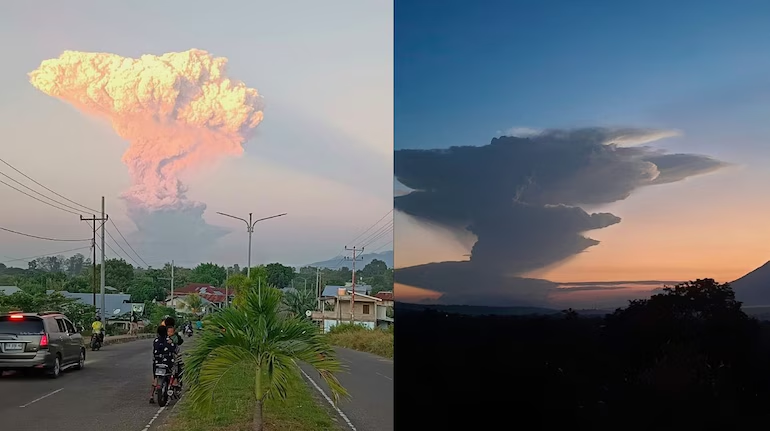Jakarta, Indonesia — In a spectacular yet terrifying display of nature’s power, Mount Ruang in North Sulawesi erupted with massive force this week, sending volcanic ash soaring into the sky and forcing thousands to flee their homes. As fiery lava lit up the night sky and ash blanketed entire villages, the eruption served as a sharp reminder of Indonesia’s position along one of the most volatile geological belts on Earth — the Pacific Ring of Fire.
The Moment the Earth Roared
The eruption began just after 2:30 a.m. local time, catching many residents off-guard. The volcanic activity had been increasing in intensity over the past week, but the sudden violence of the eruption shocked both locals and scientists.
The explosion sent an ash column over 5 kilometers (about 16,400 feet) into the air, turning the skies grey and disrupting daily life across the region. Continuous tremors and secondary eruptions followed for several hours, indicating ongoing magmatic movement beneath the surface.
“It felt like a bomb exploded under our feet,” said Yanto Lado, a fisherman who lives on Tagulandang Island. “We saw red lava spilling, and ash started falling like rain.”
Mass Evacuations Underway
Authorities have moved swiftly to evacuate over 12,000 residents living within a 6-kilometer radius of Mount Ruang. Many left behind homes, livestock, and personal belongings with little more than what they could carry.
The National Disaster Mitigation Agency (BNPB) set up more than 25 temporary shelters across nearby towns. Volunteers are distributing food, masks, and emergency supplies, while healthcare teams attend to children and the elderly suffering from respiratory issues and stress-related illnesses.

“We’ve prepared for eruptions before, but nothing on this scale in recent memory,” said Agus Wibowo, spokesperson for BNPB. “Our focus now is keeping everyone safe and accounting for those still in remote areas.”
Air Travel and Transportation Disrupted
The eruption has caused significant disruption to air traffic across the region. Several commercial flights were grounded at Sam Ratulangi International Airport in Manado, and international flights were rerouted as a precaution.
Volcanic ash is particularly dangerous to aircraft, as it can cause engine failure, reduce visibility, and damage critical components. The Indonesian Meteorology, Climatology, and Geophysics Agency (BMKG) issued advisories to neighboring countries regarding the ash cloud’s drift pattern.
Land and sea transport have also been affected. Ash-covered roads remain slippery, and ferry services between islands have been suspended temporarily.
A Country on the Ring of Fire
Indonesia is no stranger to volcanic activity. Straddling the convergence of several tectonic plates, it is home to more than 120 active volcanoes — the most of any country in the world. This eruption, however, has drawn comparisons to historic disasters such as the 2010 Mount Merapi eruption, which killed over 350 people.
Volcanologists warn that the danger may not be over. Dr. Eko Prasetyo, a senior geologist at the PVMBG (Center for Volcanology and Geological Hazard Mitigation), explains:
“The pressure beneath Mount Ruang is still fluctuating. This may have been the main event, or it could be a precursor to something larger. Continuous monitoring is critical right now.”
Environmental and Agricultural Impact
In addition to the human toll, the eruption has caused significant environmental damage. Ash fall has covered crops in North Sulawesi, threatening local food supply and livelihoods. Rivers near the volcano have been contaminated with volcanic debris, and marine life in coastal waters may also suffer from thermal and chemical pollution.

Satellite images show vegetation damage across a 10–15 km radius from the crater, and forestry officials are preparing for possible post-eruption landslides due to destabilized terrain.
Psychological and Cultural Fallout
Beyond physical damage, there is deep psychological distress among affected communities. Many residents of the region view volcanoes with both fear and reverence — they are part of ancient folklore and local beliefs.
Community leaders are working with psychologists to provide trauma support, particularly for children who were caught in the chaos of the night-time eruption.
Looking Ahead: Is the Worst Over?
As the ash slowly settles, the question on everyone’s mind is: What comes next?
Geologists will continue to monitor seismic activity and gas emissions from the volcano. Drones and satellite technology are being deployed to assess lava flow paths and potential secondary hazards such as lahar (volcanic mudflows) during the rainy season.
Meanwhile, international aid and disaster relief organizations have offered assistance, highlighting the global concern when the Earth reminds us of its unpredictable strength.
“Earth Awakens” may sound poetic, but for the people of Indonesia, this is a brutal reality. The eruption of Mount Ruang is not just a geological event — it’s a human crisis, an environmental emergency, and a wake-up call for preparedness in vulnerable regions.
As nature reclaims its voice, Indonesia once again finds itself at the epicenter of a delicate balance between beauty and destruction.
ALSO READ :POCO F7 Launches in India: Flagship Killer or Just Hype?
Last Updated on: Wednesday, June 18, 2025 10:28 pm by Muthangi Anil Kumar | Published by: Muthangi Anil Kumar on Wednesday, June 18, 2025 10:28 pm | News Categories: News

